
Press releases are designed to attract the attention of journalists and media, bringing in traffic and exposure from a large audience of new people. For a press release to capture an audience’s attention, though, it needs to have a compelling headline. After all, who will click through to the press release if the headline doesn’t draw them in?
Crafting a compelling, eye-catching, attention-grabbing headline isn’t easy, but if you know what to do – and what not to do – you have a much better chance of succeeding. So, we compiled this list of Do’s and Don’ts to make the job easier for you.
Do Cover the Five Ws
The five Ws are something many of us learned about in school and promptly forgot because we were all too young to care. Well, this is the kind of situation where they come back into relevance.
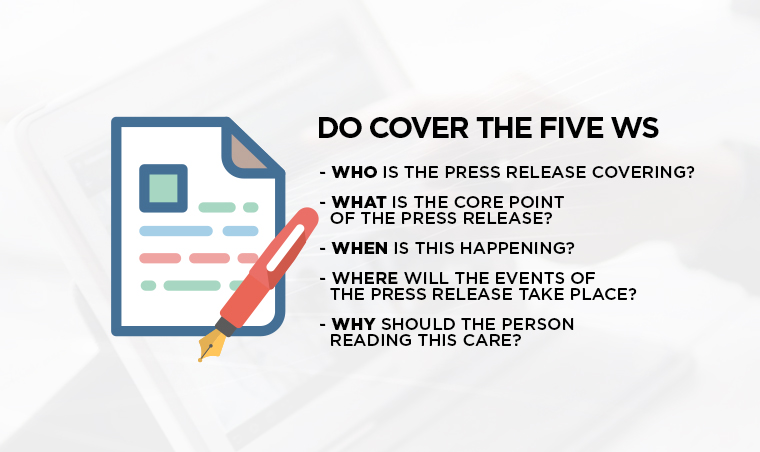
What are they?
- Who
- What
- When
- Where
- Why
These all ask essential questions that your press release will need to answer. The challenge is that your headline needs to answer at least three of them.
- Who is the press release covering? An individual, a brand, an industry, a location?
- What is the core point of the press release? Don’t play coy here.
- When is this happening? Did it already happen, and you’re reporting on it, or is it upcoming?
- Where will the press release events take place or be most relevant?
- Why should the person reading this care?
You can’t answer all of these in a single headline, but you should strive to answer as many as possible. Some can be implied; a press release about federal aid sent to a disaster zone implicitly covers the location while also covering the why and who quite easily.
Similarly, sometimes a location doesn’t matter enough to front-load it in the headline, like national- or global-level announcements from corporations.
Don’t Try to Be Too Clever
Jokes are fun, puns are great, and it’s enjoyable to read a twist on words or clever wordplay.
But, companies often try to work in a joke rather than a core point to the press release. Cleverness is, unfortunately, the enemy of clarity.

In the worst case, a joke might be referential or use a cultural or industry context that doesn’t make much sense to an outsider. Given that the people you’re sending press releases to are generally journalists and reporters – who are often outsiders – your clever headline can fall flat. A headline that doesn’t make sense or a joke that isn’t funny isn’t going to attract attention or coverage.
Do Keep Your Headline the Right Length
Here’s the biggest challenge of a press release headline: it needs to be short – super short. As in, this paragraph is already too long.
A headline should be between 8-12 words, though how many words you use depends on what kinds of short/filler words you use. More accurately, it would be best to keep it under 70 characters.
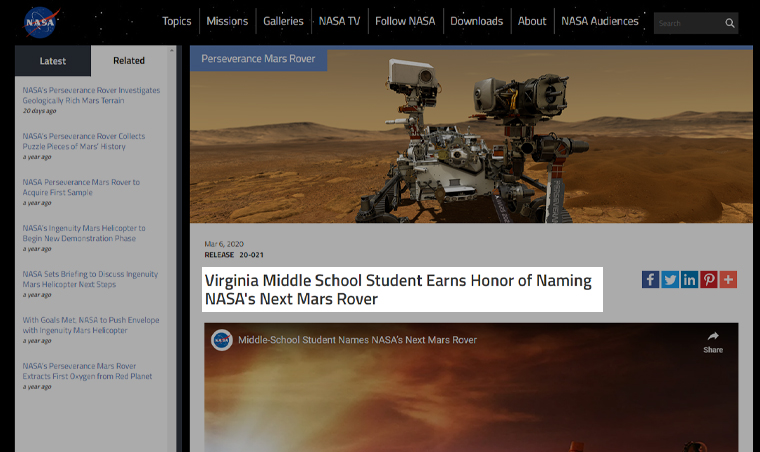
Why? Two reasons. The first is to capture attention as quickly as possible. The second is that many places where your title may be shown, like email subject lines, Google search results titles, and titles in press release indexes, have display limits. Google, in particular, truncates titles after around 70 characters, and many other sites have followed suit.
I say “around 70 characters” because Google limits the size of a page title by pixel length, as some characters take up more screen space than others (for example, the character “W” is wider than the character “i.” You can use this tool to ensure your title doesn’t exceed the limit.
Don’t Bury the Lede
The lede is generally defined as “the point.” A story with a buried lede is a story where an entire narrative or bit of reporting is presented, but the reader doesn’t know why any of it matters or lacks any of the critical contexts to the press release until the end.
For example, imagine a headline like this:
“New Developments in Construction Project in New York City”
This headline promises that there’s some development, in some type of construction project, in NYC.
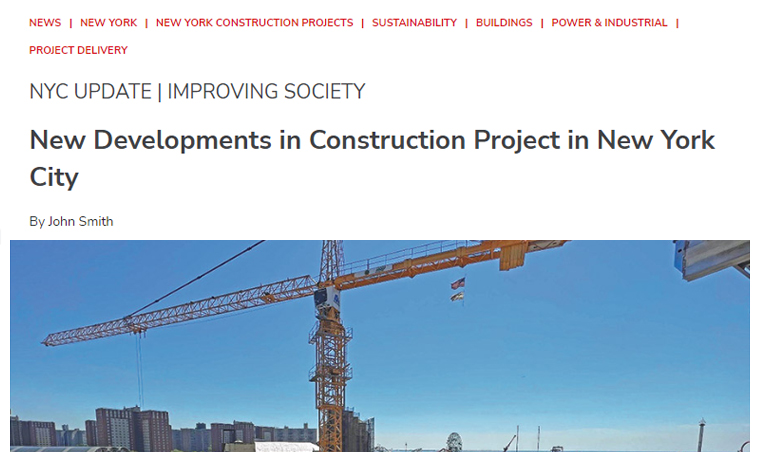
It’s not a very good headline (it only answers two of the Ws; the where and the what, and only partially the what), but more importantly, it just hints at some new developments. What are those new developments? Who knows!
Now imagine you’re reading that press release, and you don’t find out until halfway through that the “new development” is that the project is canceled. You may feel like you wasted time reading about the project when it no longer matters to anyone who wasn’t an investor. That’s a simple example of a buried lede. A better example of a headline might be:
“ABC Construction’s NYC Project Cancelled Due to Budget Cuts”
This heading tells you who, what, where, and why. It also implies the when by being news in the first place.
Do Avoid Jargon, Acronyms, and Other Deadly Words
Certain kinds of words will kill your press release headline in its crib. The journalists and editors reading it will, at best, sigh and ignore it.
At worst, they may scoff and disregard the current press release and others from you in the future.
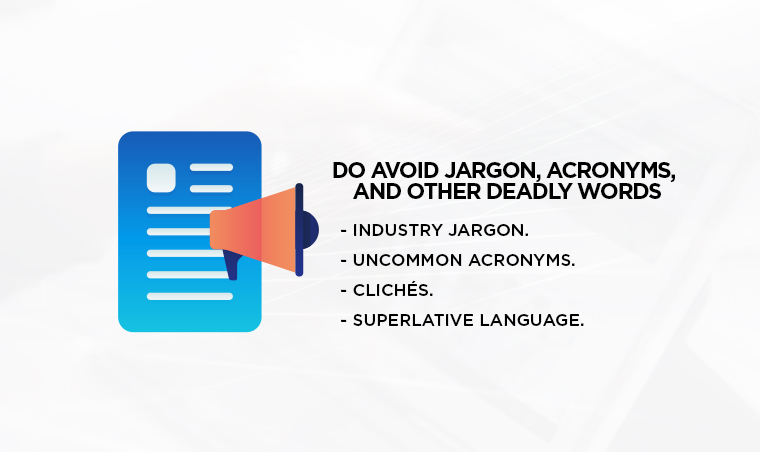
What kinds of words should you avoid?
- Industry jargon. Leave it out unless you’re restricting your press release to only industry publications with audiences you can trust to understand the terminology.
- Uncommon acronyms. Everyone knows what an ATM is, but how many people know your industry-specific acronym? If it needs to be explained, leave it out.
- Clichés. Most of the time, if you’re trying to play off a cliché, that too will be cliché. You’re not the first person to come up with it, and probably not the first person to use it in a press release headline.
- Superlative language. There’s a time and a place for using superlatives, but the press release headline is not that time or place.
Remember who will be reading your press release headline, and consider what kinds of language they will understand. When in doubt, aim for below their understanding; it’s better to be too simple than obtuse and unintelligible.
Don’t Rely on Clickbait
A handful of years ago, the internet was plagued by clickbait, usually explicitly formulated to get clicks on content that otherwise wouldn’t deserve it. For a list of 12 examples, click here; you won’t believe number 7! (No, there’s no link there.)
Clickbait was wildly influential in one thing only: getting bored people on Facebook to click through meme pages and non-news sites with tons of ads and nothing of value.

For everyone who had real news, it was a blight.
The biggest issue with clickbait is that the people who are gatekeepers for your press release – the editors, the reporters, the site owners – know from experience that clickbait rarely hides anything worth the click. Using it puts you in the same category and will get you ignored.
These days, many people avoid clickbait, no matter how enticing it is, knowing that they’ve been burned by non-stories too many times before.
Do Remember Who You’re Targeting
There are two schools of thought when it comes to writing press releases.
The first is the traditional school, and the rationale all comes back to the name: press release.
A press release, as originally intended, is a document to be given to reporters and journalists – the press – for them to be informed about a topic. The reporter can then do more investigation, learn more about the subject from various angles, and compose a piece of reporting for their publication.

The goal of a press release is similar to a story tip, to put a journalist onto the scent of a story.
But, it goes one step further to give them most (or all) of the information they would need to write the story.
Sometimes they may want to dig deeper to make sure your press release isn’t hiding the real story, but many times, you can take it at face value.
The key here is that the press release rarely sees widespread exposure. It’s meant as an inside document between you and journalists and is written as such. Writing specifically to target and entice journalists is a very different kind of writing than something you would write to be broadly sharable on Twitter or Facebook.
The second school is the new school, which recognizes that press releases today are often posted as-is, on press release sites, or in some publications. Thus, the press release needs to be written more generally enticing and compatible. There might not be any editorializing or added context from a journalist, and the press release needs to stand on its own.
These two are not incompatible with one another. Still, it may be beneficial to know how your readers will treat your press release, where you will send it, and whether or not it will be published as-is in a venue for the average consumer to read.
Don’t Issue Press Releases for Non-News
One of the biggest sins of the press release is companies using the format to promote things that aren’t newsworthy. When you put out a press release every time your management makes a decision, every v0.01 update of your software, every financial statement, and every tweet your CEO makes, it devalues them. Not just press releases as a whole but specifically the press releases your company produces.
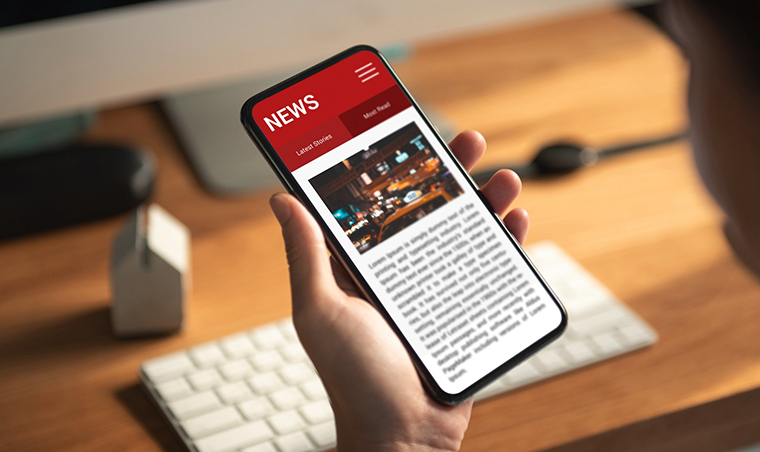
What happens when you finally have something essential and newsworthy to announce? You’re using an announcement and news format for things that aren’t important enough to warrant it. In a way, you can think of it like the “Boy Who Cried Wolf.”
You’ll make a press release and send it out; visitors will roundly ignore you. You’ll have burned that bridge already.
Your headline is the key here, in a sense. If you can’t figure out how to create a headline that would make high-importance, time-limited people stop and think they need to read it; it’s not likely newsworthy enough to announce in a press release.
Do Use Numbers Whenever Possible
Numbers are interesting.
The human mind finds them unusually compelling, and yet they’re so easy to use to mislead.

Imagine these headlines:
“ABC Retail Sales Increase”
“ABC Retail Shows 10x Increase in Sales”
Which one is more compelling? The second one. But does it tell the whole story? A company that sold one item last year and ten this year experienced a 10x increase, but it’s not entirely meaningful. Still, using numbers when you can helps with specificity and with attractiveness in your headlines.
Don’t Waste Space with Unnecessary Names
A press release announcing that you hired a new financial manager can be fine if your business is large enough to make that news. Still, the specific name of the new hire is unlikely to be significant enough to include in the headline.

Remember your character limits! Few people worldwide are prevalent enough to have their names in a press release unless the release is specifically about them.
Do Save the Headline for Last
When you start with a headline, then write your press release, you may find that the release goes off-track. While this might sound counterintuitive, the headline is essential enough that it should be among the last things you write.

When you create your press plan, write your release, and then craft a headline, the headline will ideally be in tune with the content.
Don’t Make the Headline an Afterthought
Even if you’re writing it last, your headline needs your full attention. Remember, even if you’re writing it at the end, and you’re tired, and you’re familiar with the topic enough that you might not know what other people need to know, you still need to sit back, relax, and focus on the headline. It can’t be an afterthought.

If this sounds unnecessarily complex and confusing, we have good news: we’re experts in creating and distributing high-quality press releases. If you’re interested in offloading the responsibility to people who know all of these “Do’s and Don’ts” intimately, look no further.
